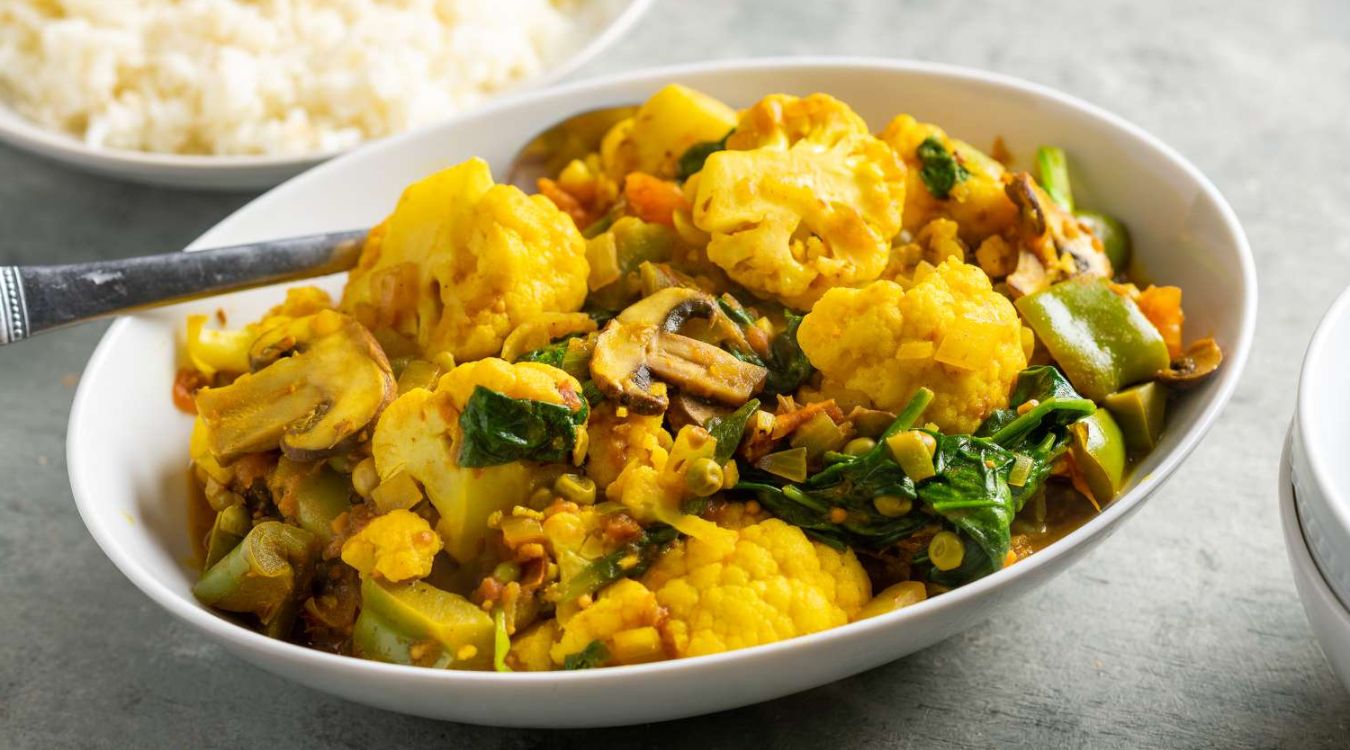This delightful Indian sabji recipe is a perfect blend of spices and mixed vegetables, making it a wholesome and flavorful dish. It's a versatile recipe that can be enjoyed with roti or rice, offering a comforting meal that's both nutritious and satisfying.
Some ingredients in this recipe might not be commonly found in every household. For instance, garam masala is a special spice blend used in Indian cuisine, and coriander leaves (also known as cilantro) add a fresh, aromatic touch. These can be easily found in the spice or produce section of most supermarkets.

Ingredients For Indian Sabji Recipe
Oil: Used for sautéing the spices and vegetables, providing a base for the dish.
Cumin seeds: Adds a warm, earthy flavor to the dish when spluttered in hot oil.
Onions: Chopped and sautéed until golden brown, they form the base of the sabji.
Tomatoes: Chopped and cooked until soft, they add a tangy flavor and moisture to the dish.
Mixed vegetables: A combination of carrots, peas, and potatoes, providing a variety of textures and flavors.
Turmeric powder: Adds a vibrant yellow color and a mild, earthy flavor.
Red chili powder: Adds heat and a deep red color to the sabji.
Garam masala: A blend of ground spices that adds warmth and complexity to the dish.
Salt: Enhances the flavors of all the ingredients.
Coriander leaves: Chopped and added at the end for a fresh, aromatic finish.
Technique Tip for This Recipe
When sautéing the onions, make sure to cook them until they are a deep golden brown. This caramelization process enhances the sweetness and depth of flavor in the sabji. Additionally, when adding the tomatoes, cook them until they are completely soft and have melded with the onions to form a rich base. This ensures that the spices and vegetables will be well-coated and infused with flavor.
Suggested Side Dishes
Alternative Ingredients
oil - Substitute with ghee: Ghee adds a rich, buttery flavor and is commonly used in Indian cooking.
cumin seeds - Substitute with caraway seeds: Caraway seeds have a similar earthy flavor and can mimic the taste of cumin.
chopped onions - Substitute with shallots: Shallots offer a milder and slightly sweeter flavor compared to onions.
chopped tomatoes - Substitute with tomato puree: Tomato puree provides a similar texture and concentrated tomato flavor.
mixed vegetables (carrots, peas, potatoes) - Substitute with zucchini, bell peppers, and cauliflower: These vegetables offer a different texture and flavor profile but work well in a sabji.
turmeric powder - Substitute with saffron: Saffron provides a unique flavor and a similar yellow color, though it is more aromatic.
red chili powder - Substitute with cayenne pepper: Cayenne pepper offers a similar level of heat and can be used in the same quantity.
garam masala - Substitute with curry powder: Curry powder has a different blend of spices but can provide a similar depth of flavor.
salt - Substitute with soy sauce: Soy sauce adds saltiness along with a bit of umami flavor.
chopped coriander leaves - Substitute with parsley: Parsley provides a fresh, slightly peppery flavor and a similar green color.
Other Alternative Recipes Similar to This Dish
How To Store / Freeze This Dish
Allow the sabji to cool completely before storing. This prevents condensation, which can make the vegetables soggy.
Transfer the cooled sabji into an airtight container. Ensure the container is clean and dry to maintain the freshness of the dish.
Label the container with the date of preparation. This helps in keeping track of how long the sabji has been stored.
Store the container in the refrigerator if you plan to consume the sabji within 3-4 days. The cool temperature will keep the vegetables fresh and flavorful.
For longer storage, place the container in the freezer. The sabji can be frozen for up to 2-3 months without losing its taste and texture.
When ready to eat, thaw the sabji in the refrigerator overnight. This gradual thawing process helps retain the quality of the vegetables.
Reheat the sabji on the stovetop over medium heat. Add a splash of water if needed to prevent it from drying out.
Alternatively, you can reheat the sabji in the microwave. Use a microwave-safe dish, cover it loosely, and heat in short intervals, stirring occasionally to ensure even heating.
Garnish with fresh coriander leaves before serving to revive the flavors and add a touch of freshness.
Enjoy your reheated sabji with roti or rice, just as delicious as when it was freshly made.
How To Reheat Leftovers
Stovetop Method: Heat a non-stick pan over medium heat. Add a splash of oil or a few tablespoons of water to prevent sticking. Add the leftover Indian Sabji and stir occasionally until heated through. This method helps retain the texture of the vegetables.
Microwave Method: Place the Indian Sabji in a microwave-safe dish. Cover with a microwave-safe lid or plastic wrap with a small vent. Heat on high for 2-3 minutes, stirring halfway through to ensure even heating. Let it sit for a minute before serving.
Oven Method: Preheat your oven to 350°F (175°C). Transfer the Indian Sabji to an oven-safe dish and cover with aluminum foil. Bake for about 15-20 minutes or until heated through. This method is great for reheating larger quantities.
Steaming Method: Place the Indian Sabji in a heatproof dish that fits into a steamer basket. Steam over boiling water for about 5-7 minutes or until hot. This method helps retain moisture and flavor.
Instant Pot Method: Use the sauté function on your Instant Pot. Add a small amount of oil or water and the leftover Indian Sabji. Stir occasionally until heated through. This method is quick and efficient.
Air Fryer Method: Preheat your air fryer to 350°F (175°C). Place the Indian Sabji in the air fryer basket and heat for about 5-7 minutes, shaking the basket halfway through. This method can give a slightly crispy texture to the vegetables.
Best Tools for This Recipe
Pan: A broad, flat-bottomed cooking vessel used for sautéing and cooking the vegetables evenly.
Spatula: A flat, broad-bladed utensil used for stirring and mixing ingredients in the pan.
Knife: A sharp tool used for chopping onions, tomatoes, and mixed vegetables.
Cutting board: A durable board on which to place vegetables for chopping.
Measuring spoons: Tools used to measure out the oil, cumin seeds, turmeric powder, red chili powder, and garam masala accurately.
Mixing bowl: A bowl used to hold and mix the chopped vegetables before adding them to the pan.
Lid: A cover used to trap steam and heat while cooking the vegetables on low heat.
Serving spoon: A large spoon used for serving the cooked sabji onto plates or bowls.
Serving dish: A dish used to present the sabji when serving it with roti or rice.
How to Save Time on This Recipe
Pre-chop vegetables: Chop all vegetables in advance and store them in the fridge to save time during cooking.
Use a food processor: A food processor can quickly chop onions and tomatoes, reducing prep time.
Cook in bulk: Prepare a larger batch of sabji and store portions in the freezer for quick meals later.
Pre-mix spices: Combine spices like turmeric powder, red chili powder, and garam masala in a small container beforehand.
Use frozen vegetables: Opt for frozen mixed vegetables to skip the chopping and save time.

Indian Sabji Recipe
Ingredients
Main Ingredients
- 2 tablespoon Oil
- 1 teaspoon Cumin Seeds
- 1 cup Chopped Onions
- 1 cup Chopped Tomatoes
- 2 cups Mixed Vegetables (carrots, peas, potatoes)
- 1 teaspoon Turmeric Powder
- 1 teaspoon Red Chili Powder
- 1 teaspoon Garam Masala
- to taste Salt
- 2 tablespoon Chopped Coriander Leaves
Instructions
- Heat oil in a pan. Add cumin seeds and let them splutter.
- Add chopped onions and sauté until golden brown.
- Add chopped tomatoes and cook until soft.
- Add mixed vegetables, turmeric powder, red chili powder, and salt. Mix well.
- Cover and cook on low heat until vegetables are tender.
- Add garam masala and chopped coriander leaves. Mix well and cook for another 2 minutes.
- Serve hot with roti or rice.
Nutritional Value
Keywords
Suggested Appetizers and Desserts
More Amazing Recipes to Try 🙂
- Small Batch Blueberry Jam Recipe40 Minutes
- Indian Masala Bhindi Fry Recipe35 Minutes
- Indian Vada Curry Recipe1 Hours 10 Minutes
- Cream Cheese Frosting Recipe10 Minutes
- Baked Indian Samosas Recipe55 Minutes
- Indian Okra and Tomato Stir Fry Recipe30 Minutes
- Indian Pizza Recipe35 Minutes
- Indian Kasoori Methi Aloo Recipe35 Minutes

Leave a Reply